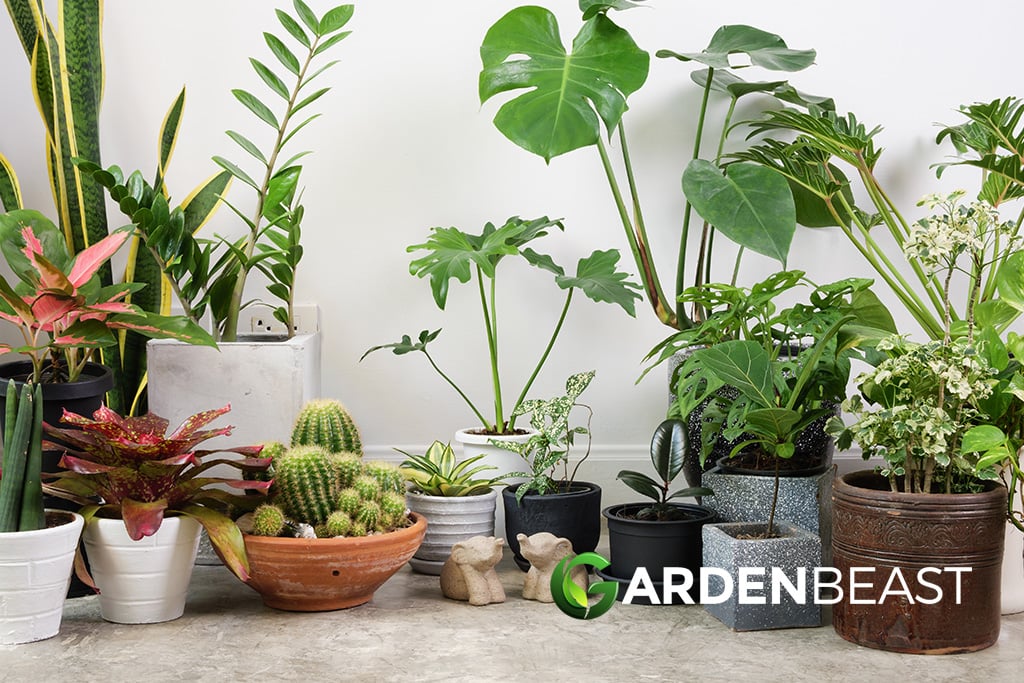The latest “Monstera Mania“, probably fueled by a global pandemic that confined people across the globe to their homes, left to take pictures of plants, is far from the first time people found themselves in the grip of a botanical buzz, then.
Houseplants are wonderful, and help us connect with nature every single day — quite literally helping us to sleep more easily and enjoy a better quality of life. Really, though? Who wants to spend $400 on a fiddle leaf fig, or up to $ 5,000 (yes, that’s three zeroes) on a coveted variegated Monstera? And not even a fully grown plant, but just a cutting or even a node?
Not you, apparently, or you wouldn’t be reading this. Keeping in mind that literally every plant is unique, uniquely beautiful, and uniquely right for some (indoor) gardener or another, there are plenty of ways to get plants cheaply. It just depends on the plant.
Keep reading to discover how to enjoy plants without buying your way to homelessness, which would kind of take the “house” out of houseplant.
1. Ask Your Friends, Relatives, and Distant Acquaintances for Cuttings
So, you truly have your heart set on that variegated Monstera, Philodendron ‘Pink Princess’, Philodendron ‘Paraiso Verde’, or Anthurium regale? You just don’t have the money to pay the current market rate, or simply don’t want to — which would make sense, because you shouldn’t need a second mortgage to enjoy some nice houseplants?
- Friends, relatives, coworkers, neighbors, or that girl you once met through friends at a party, are realistically already tired of people asking them for cuttings.
- This route is, however, your very best bet if you would like to get your hands on a rare and expensive houseplant cheaply.
- Ask nicely — very nicely. Do not beg, and do not expect anyone to give you cuttings worth hundreds (or sometimes even thousands) of dollars for free.
- Do ask for a friendly price, and you may just be in luck. Hint: The closer you are with an avid indoor gardener who grows rare plants, the higher your odds of success.
Keep in mind that cuttings can only safely be taken from most plants during certain times of the year, and that overpruning will send rare plants to the afterlife. If someone tells you that you may be able to have a cutting “later”, do not nag. You may be rewarded with the loot you were after.

2. Pay the Price, and See Your Rare Plant as an Investment
Don’t know anyone in possession of the rare and highly-coveted houseplant you would love to grow in your home?
You’ll likely have to bite the bullet and pay the full market price. You can think of your purchase as a long-term investment if you plan on selling cuttings from this plant later, once the plant is mature.
In this case, we would highly recommend that you buy your plants from reputable local nurseries wherever possible. This will allow you to view the plant before purchasing it. Professional online retailers can also be a your path to success, but make sure to check them out thoroughly first.
What’s with all the paranoia, you ask? As the houseplant craze continues, many unscrupulous sellers attempt to scam wannabe plant parents out of a fortune by passing far more common houseplants off as rare and expensive ones, even going as far as to paint them or Photoshop pictures to sell potential buyers on the idea that they are getting unique varieties.
This is especially true when it comes to variegated Monstera plants. Indeed, some scammers have been known to sell pictures of variegated Monsteras on ebay, tricking buyers into believing they would get the actual plant.

On the other hand, you have the botanical equivalent of puppy mills — people who sell small cuttings that have little chance of succeeding, or even just nodes, trimming their rare plants into an early grave to make a quick buck. As a plant lover, you’ll agree that that’s not OK, either.
The moral of the story is this — do your research before buying a rare and expensive plant, and you’ll be golden.
3. Join a Local Horticultural Club
You’ll not just learn everything you need to know about keeping rare houseplants alive and thriving, but you will also be able to network to your heart’s content. Even if your local horticultural club does not have regular plant sales, as many do, you will inevitably meet people who are happy to share cuttings with you if your love of plants is genuine.
4. Look Into Plant Rescue Groups
Yes, that’s a thing. Not everyone is able to offer a rare high-maintenance plant the care it deserves, and keen horticulturists also occasionally pass away. Sometimes, the plants these people leave behind end up in the temporary care of plant rescue groups, which will save them from certain death by finding new homes for them. Not every area has one of these groups, but if you do, you may have a chance to get your hands on a wonderful plant that would otherwise have been left to die.

5. Become Very Friendly with Local Plant Nurseries
This offers several opportunities. Many nurseries occasionally have big sales, including end of season sales where you can get the best bargain on a wonderful plant. If your nursery is well-organized, it probably has an email list. Getting on it will inform you about sales before more casual shoppers get wind of bargain-hunting opportunities. Even if your nursery is a mom ‘n pop operation, you may be able to convince the business owners to give you a call about upcoming sales.
Nurseries will also sometimes discard plants that they have not been able to sell, or that are slightly damaged. Plant enthusiasts who manage to get on the nursery’s good side may be able to get such a plant for free and nurse it back to health.

6. Attend Yard or Estate Sales
People move, including far away or overseas. People die, too. In either case, they often won’t be able to take their beloved houseplants with them.
This explains why yard sales and estate sales often offer a treasure trove of great houseplants, including rare and expensive houseplants like Monsteras or Philodendrons.
Joining a Facebook group dedicated to your neighborhood is often a wonderful way to find out about these sales, but you can also come across them as you drive around sometimes.
7. Engage in Plant Swaps
Do you have a few rare and expensive houseplants? Capitalize on that by propagating your plants and, where possible, growing them to maturity. Plant swaps are a wonderful option for people who do already have some coveted plants, but who would absolutely love to add different species to their collections.
These events, which can unfold online or in person, work pretty much as the name suggests — you give someone else a mature plant or a new cutting, and in return you receive a different one. This modern form of bartering can allow you to fill your home with a variety of gorgeous plants, as you can trade one species of plant with multiple people who will all give you different plants in return.

8. Allow Yourself to Fall in Love with Cheaper Plants, Which Are No Less Wonderful
Finally, keep in mind that not all plant species have been caught up in the recent houseplant craze — your local grocery store probably sells some wonderful plants, including inch plants and Venus fly traps, for two figures or even less.
Additionally, you’ll be able to find wildflowers to plant in your garden by the side of the road, and come home with a bumper crop after visiting your local plant nursery without going into debt. The key? Don’t go for “Insta It Plants”, and choose which plants may be right for you by asking:
- Which plants do I genuinely love the look of?
- Which plants can I offer the best care to? (Consider temperature, humidity, and lighting conditions in your home, and be honest with yourself about your skill level and the amount of time you have to devote to caring for houseplants.)
- Which plants would brighten my interior up?
Even the most common plants can look wonderful, and you never know — plant species that currently won’t break the bank may become all the rage tomorrow.
The Best Cheap Houseplants
Not sure which affordable houseplants might make a great permanent addition to your home? Consider some of thees beauties:
- Flaming Katy (Kalanchoe blossfeldiana) belongs to the Crassulaceae family and offers intricate pink, red, or orange flowers. These succulents are not just very affordable, they are also easy to grow and care for and will quickly reward you with a new set of flowers when its blooms wane. These plants thrive in partial shade and in room temperature, making them perfect houseplants.
- Pothos (Epipremnum aureum) may be incredibly popular, but it remains surprisingly cheap and easy to acquire. These trailing vines have beautiful variegated evergreen leaves, and lucky indoor gardeners may even catch a glimpse of their spadix flowers once in a while.
- The snake plant (Sansevieria trifasciata), also called mother-in-law’s tongue, is a very Instgrammable plant that features long wavy leaves, which are deep green in the center and have creamy edges. Snake plants do best in partial shade and with very little watering — only water the snake plant once its soil has dried out completely.
- The spider plant (Chlorophytum comosum) is a delightful tropical perennial that is easy to care for and to propagate; this plant gives rise to “spiderettes” that can be planted to form new plants. It has beautiful leaves, which can be variegated, and thrives in dappled sun, partial shade, or even deep shade.
- The friendship plant (Pilea involucrata) has highly textured and unusual ovate leaves; go for a deep purple shade if you are looking for a rare plant. They remain affordable, and need dappled sun to thrive. Friendship plants may not look like much when photographed from a distance, but zoom in and they can certainly compete with the Monsteras everyone seems to be after these days.
- The bamboo palm (Chamaedorea seifrizii) is a small subtropical palm that is often grown as a houseplant, in which case it can easily grow to reach your ceiling over time. This thirsty plant needs plenty of moisture and thrives in dappled sun.
That, of course, is just the start of a very long list of beautiful plants that are easy to grow and care for, and that are still cheap to acquire. Joining the hunt for rare and expensive plants is certainly one option, but it’s far from your only one.
In Conclusion
Well-connected indoor gardeners have a good chance of bringing a rare and expensive plant, like a variegated Monstera, home for a friendly price. Everyone else will just have to pay the price — or choose from among the many beautiful and every bit as photogenic plants that are still cheap to buy.
Why limit yourself to the few plants that have become so popular when you have so many more options?
